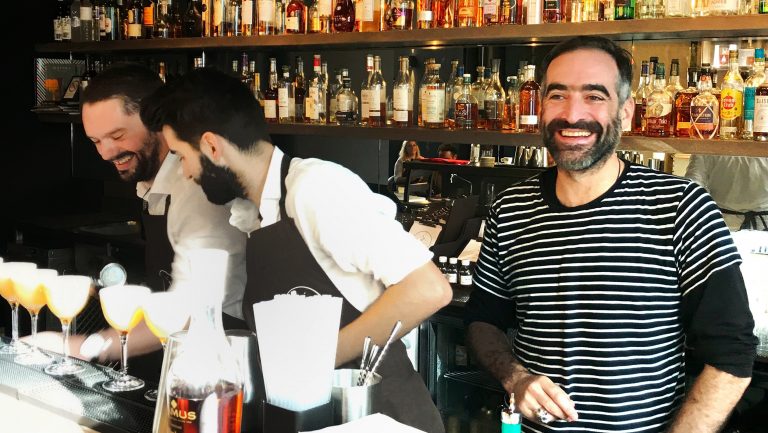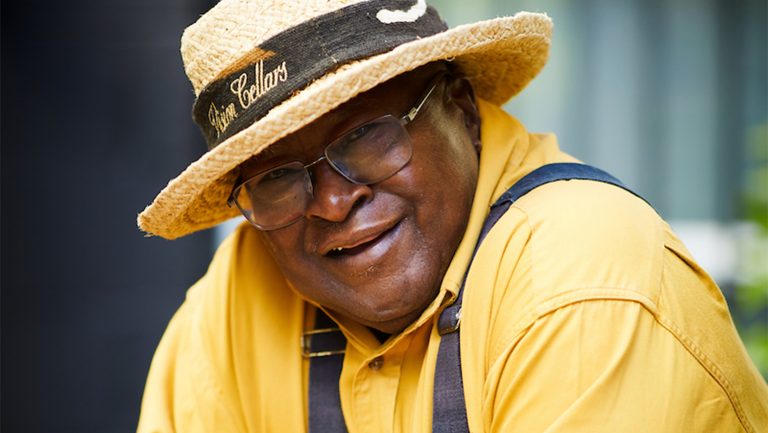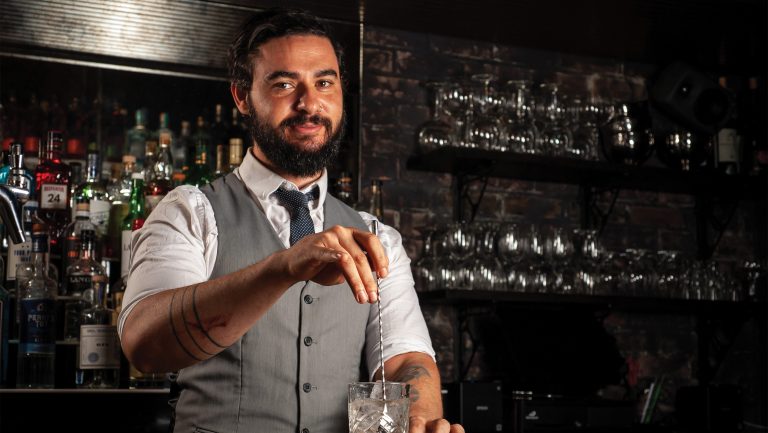A little while back, at his Bar Termini in London, Tony Conigliaro—an icon of the 20th–century cocktail revival—created his version of a Bellini with peach puree and almond blossom liqueur for an Italian newspaper photo shoot. After the shoot wrapped, the photographer took a sip. “And then she started crying,” Conigliaro says. “Like really crying. I asked her, ‘What’s wrong?’ And she said, ‘I haven’t been home in three years.’”
“It’s not ideal to have people crying in your bar,” Conigliaro added, with a laugh. “But this offers a good idea of how emotive flavor and aroma can be.”
Conigliaro has long had an outsized reputation for being on the cutting edge of mixology. Robert Simonson, in his comprehensive history of the craft cocktail movement, A Proper Drink, called Conigliaro “a science-based cocktail eminence in London” and one of the “twin totems of molecular cocktail wizardry” (along with Dave Arnold in New York City). Indeed, in Conigliaro’s 2012 book, The Cocktail Lab, the recipe for his Cosmo Popcorn reads like something from a manual for operating a small nuclear reactor. “The science behind this novelty drink unfortunately results in utter impracticality for service at a bar,” the book warns. “Use of liquid nitrogen should be confined only to the professional kitchen.”

Don’t miss the latest drinks industry news and insights. Sign up for our award-winning newsletters and get insider intel, resources, and trends delivered to your inbox every week.
Yet Conigliaro doesn’t come across like a mad scientist—there’s no manic energy or wild hair. He’s soft-spoken and projects a low-key vibe, doesn’t wear flashy clothes, and I’m pretty sure his neatly trimmed salt-and-pepper beard will win no bartender competitions. Similarly, his cocktails often come across as simple even if they’re anything but—many are laboriously crafted through long experimentation at his Drink Factory, a sort of high-tech skunkworks where Conigliaro and his team of researchers employ inscrutable equipment and techniques to compound intricate, unexpected flavors and textures. (This includes his famous Prairie Oyster, a quirkily deconstructed Bloody Mary looking like an egg meant to be slurped from a ceramic oyster shell.)
But the high-tech engineering of flavors engages Conigliaro only so far. He’s equally intrigued by the way in which all of one’s senses can almost imperceptibly combine to create deep and profound emotions in drinkers at his bars. “We try to tell a story in as few words as possible.” Conigliaro says. “I truly believe you can communicate through flavor—just like words and language can be used to communicate the world outside us. The more senses you can trigger—sight, sound, taste, aroma—the more the memory will be formed.”
Conigliaro has been engineering memories in the half-dozen bars in which he’s partnered over the past nine years, not to mention the dozens of bars he’s worked with through the Drink Factory. Last fall he talked about his process to a group of bartenders, distillers, and journalists at his most recent project, Bar Luciole—a cognac-focused bar in (of all places) Cognac, France. He and his partners spent several years searching for the right space and finally found it in an historic building on the banks of the Charente River, a short stroll from Hennessy’s warehouse and directly across the waterway from the Baron Otard Château Royal de Cognac.
Conigliaro has been in the industry for two decades, having worked in several notable bars and served as a protégé to the late, legendary London bartender Dick Bradsell, before opening his first place, 69 Colebrooke Row, in Islington nine years ago, Located in an unremarkable neighborhood, the bar continues to attract both cocktail pilgrims and neighbors looking for a quiet drink. Guests step through its doors and feel as if they’ve entered a faded, vintage postcard: black-and-white checked floor, white walls, and dark wood trim. It’s all straightforward and comforting, with seats for about 40 (including five along a cramped bar). The service is also vaguely sepia-toned—bartenders in tidy white jackets efficiently bring glasses of water even before you settle in.
When it opened, 69 Colebrooke Row received immediate notice thanks to its relentless emphasis on simplicity and grace. Although seemingly modest, the drinks perform acrobatics on the palate, and many were designed to trigger specific emotional responses, whether guests were aware of that or not.
Each of Conigliaro’s bar ventures has started with the setting. His aim isn’t to wow when guests enter—after all, a stage-set designer has failed if the backdrop overwhelms the story. The space is conceived chiefly to enhance the mood created through cocktails and service.
When Conigliaro opened Bar Termini, a bar and coffee shop, in London’s Soho neighborhood in 2012, he was inspired by a particular coffee shop in Rome’s Termini train station, and more specifically the feeling conveyed in black-and-white movies from the ’50s. His initial question was, “How do we create an idealized version of an Italian aperitivo coffee bar in the middle of London?”
“If you look at any film from the 1950s with a train station in it,” Conigliaro says, “what you have is sorrow that someone is leaving, or great joy that someone is arriving. So we wrote the script for the staff such that when they talk to the customer—great joy when you arrive, and sorrow when you leave.” Staff training was built around those moments of effusive greetings and bittersweet departures.
The idea was to create moments more intensely felt than everyday life. “People come in and use [the bar] like a train station bar—they pop in and pop out, they have a coffee or a Negroni,” Conigliaro says. His team brainstormed ways of greeting each customer to highlight the sense of arrival. “Someone suggested scattering rose petals as they came in,” Conigliaro recalls. “This would be very messy and the staff would kill me.“ Eventually a small faux rose petal was concocted from rose powder, beetroot, and blood currant. Offered to each guest as a quiet welcome, it provides tannins to clear the palate and ready guests for their first drink.
Once guests have been greeted and settle in, they can consider the cocktail list, which includes variations on classics, including the Negroni. Conigliaro’s team developed four versions of the Negroni—classico, robusto, superiore, and rosato—with flavors made richer and more intense through a sous vide process, whereby the drink is essentially cooked in advance, an approach Conigliaro had been tinkering with since 2005.
For his next London bar, Untitled, which opened in 2016, Conigliaro took a different approach, although one still anchored to emotion. Inspired by Andy Warhol’s famous Factory, the space embraced an assertively minimalist aesthetic, like that of a sleek art museum awaiting art. Within this framework, Conigliaro focused more on connecting guests with one another. Toward that end, he commissioned a long, monolithic concrete table for the center of the space, surrounded with backless upholstered bar stools. “The idea was to create a table that people could sit around and communicate with those next to them and across from them and get involved with everyone else,” he says. “Which is how a true bar should work—it shouldn’t be little niches of people hiding away.”
Conigliaro worked closely with a sound engineer to craft a soundscape for the minimalist space such that the noise level would be consistent and conducive to talking—with background music automatically rising and falling relative to the ambient sound from guests.
The minimalist aesthetic applied not only to interior design—Conigliaro eschewed a back bar—but to the drink menu itself. This resulted in drinks with one-word names designed to capture a specific emotion. Among them was Snow, built around the sense memory of catching a snowflake on one’s tongue. “It took us two years to create that drink,” he said. He wanted a faint metallic taste and an instant cooling effect, which his team eventually found using enoki—a delicate mushroom. When he served the drink to 50 Icelandic bartenders and asked what they thought of, most said, “Snow.” “So we kind of got that right,” Conigliaro says. The Financial Times wrote that it was “strange, ephemeral—a drink that doesn’t just capture the flavor of [snow], but the emotional memory of it, too.”
Bar Luciole, which Conigliaro opened with his business partner Guillaume Le Dorner, marks a departure from his usual approach. The space feels less experimental and more assertively classic, with soot-dark walls, a concrete bar, and comfortable leather chesterfield sofas arrayed to take in the late afternoon light through soaring windows. Upstairs, guest rooms are being built, to be completed next summer, for visiting bartenders and cognac experts.
The centerpiece at the bar is a wall of dozens of rare cognacs set behind glass, like a reliquary. Conigliaro’s goal is to highlight the rare variations from smaller, lesser-known cognac houses with tasting flights that provide examples across different producers, as most tastings available to visitors in the region are limited to a single producer.
“Here, we’re able to realize a different kind of project,” Conigliaro says, as it’s more “outward facing”—looking to connect to the many nearby cognac houses and to tap into the deep reservoirs of history and knowledge about the spirit. “What we’ve tried to do is look at cognac cocktails from a historical point of view,” he says. Among the cocktails served at Bar Luciole are the Avignon, made with cognac and chamomile syrup and served in a frankincense-smoked glass; and a Martini des Charentes, made with gin and Pineau des Charentes, a locally popular aperitif.
Many of the cognac cocktails began back across the Channel. Le Dorner, who had been working at 69 Colebrooke Row, spent hours tinkering at the Drink Factory—refining and reworking classic cocktails, bringing in new cognacs as he discovered them, improving the drinks when he could, leaving them alone when he couldn’t, and finding ways to best use the many cognacs available to them. Says Conigliaro, “We’ve probably made more versions of cognac cocktails than anyone else in the world.”
This prolific experimentation is another indication of the influence of the Drink Factory. Conigliaro and his team of seven researchers are constantly working with vacuum pumps, centrifuges, refractometers, and other arcane equipment to craft drinks that have heretofore never been imagined, let alone attempted. But most of all, the equipment provides him tools to tell a story, whether of an Italian train station, or the traditions of Cognac.

Dispatch
Sign up for our award-winning newsletter
Don’t miss the latest drinks industry news and insights—delivered to your inbox every week.
Wayne Curtis is the author of And a Bottle of Rum: A History of the New World in Ten Cocktails and has written frequently about spirits for The Atlantic, Imbibe Magazine, Punch, The Daily Beast, and Garden & Gun, among others.







